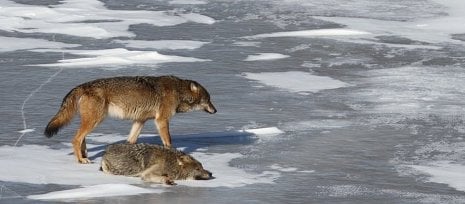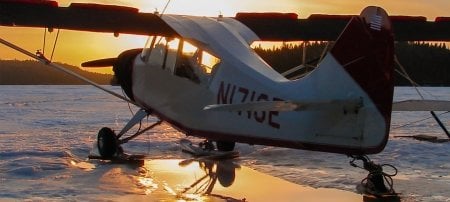Isle Royale Wolves Fall Prey to Inbreeding Problems

Michigan Technological University’s annual Winter Study of the wolves and moose of Isle Royale National Park counted eight wolves on the island this winter, down one from last year. And as far as the researchers could tell, no wolf pups were born in 2012.
“This is the first year since 1971, the year reproduction first began being monitored, that we did not detect any sign that pups had been born during the past year,” wrote John Vucetich, the Michigan Tech population biologist who heads the annual study, in the 2012-203 Winter Study annual report released this week
“We failed to detect signs of courtship or mating in the Chippewa Harbor Pack in either of the past two winters,” Vucetich went on to say. “This winter, we observed signs of courtship in the West-end Trio, but we cannot say if mating occurred.”
“The lack of reproduction is not due to a shortage of females,” Vucetich said. DNA analysis of wolf scat suggests that the wolf population includes three to five females.
The wolves do not appear to be having difficulty capturing prey either, since the moose population on Isle Royale has increased dramatically. Moose comprise the wolves’ primary food source. From a low of 400 in 2007, the number of moose has more than doubled to 975 this year.
Calves are very abundant this year, making up 21 percent of the moose population. This year researchers tallied 10 sets of twins during their survey flights, compared to three sets last winter and three total in winters 2010 and 2011.
An important reason for the reproductive success seen among the moose is this winter’s low predation rate, said Vucetich and co-author, Research Professor Rolf Peterson, in the annual report. The predation rate is the percentage of the moose population over nine months old that are killed during the year by wolves. In 2009, the predation rate on Isle Royale was 17.4 percent. Last year, it dropped to an all-time low of 3.3 percent, and this year’s rate was even lower: 2.4 percent.
“When fewer moose are being killed, more moose are surviving to reproduce, and more calves are surviving to become reproducing adults,” Vucetich explained.
So there are plenty of females and plenty of food. Why are the wolves not reproducing?
“It could be inbreeding, which can affect survival and reproduction,” Vucetich suggested. “Also, wolves, like most animals, have an instinct to avoid breeding with close relatives. Somehow they sense which mate would allow for genetic viability.”
All of the wolves at Isle Royale National Park are highly inbred. The Isle Royale wolf population was founded from three wolves—a female and two males—that arrived on Isle Royale more than five decades ago. All the wolves on Isle Royale descended from those animals until 1997, when a lone male wolf crossed an ice bridge to the island from Ontario.
“The genetic input from that immigrant seemed to breathe new life into the population,’ Vucetich and Peterson point out.
However, 16 years have passed since new genes were introduced into the gene pool of the wolves of Isle Royale. The newcomer was prolific. Within 2.5 generations, every wolf on the island was related to him. So inbreeding continues to be a serious concern.
The Isle Royale wolves already show spinal anomalies that are a result of close inbreeding for several generations, and there are likely other physical or physiological effects, the researchers say.
Most wolves have an average life span of less than five years. If the wolves on Isle Royale continue not to breed, the population will soon be gone.
The National Park Service (NPS) is reviewing possible management responses to the possibility that wolves could go extinct. “We are still a ways off from making any decision about the future management of wolves on the island,” said Paul Brown, chief of natural resources at Isle Royale National Park. “We remain concerned about the overall long-term health of the population, and the results of this year’s winter study will be factored in with the genetics information during our on-going review of the situation.”
NPS plans to conduct a meeting of interested and knowledgeable scientists and a public forum before making a decision.
The Wolf-Moose Predator-Prey study at Isle Royale National Park is in its 55th year. It is the longest running predator-prey study in the world.
Major funding for the Wolf-Moose Predator-Prey research comes from the National Park Service, the National Science Foundation, funds from the Dick and Bonnie Robbins Chair in Sustainable Management of the Environment—held by Rolf Peterson—and the Robert Bateman Endowment at the Michigan Tech Fund.
Michigan Technological University is a public research university founded in 1885 in Houghton, Michigan, and is home to more than 7,000 students from 55 countries around the world. Consistently ranked among the best universities in the country for return on investment, Michigan’s flagship technological university offers more than 120 undergraduate and graduate degree programs in science and technology, engineering, computing, forestry, business and economics, health professions, humanities, mathematics, social sciences, and the arts. The rural campus is situated just miles from Lake Superior in Michigan's Upper Peninsula, offering year-round opportunities for outdoor adventure.




Comments